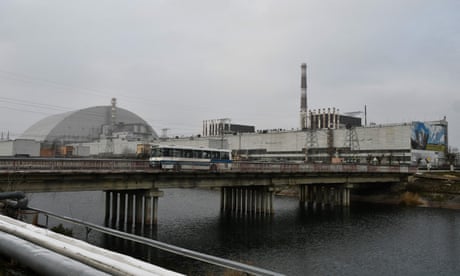- by foxnews
- 23 May 2025
Fears mount for safety of Ukraine’s nuclear reactors amid Russian invasion
Fears mount for safety of Ukraine’s nuclear reactors amid Russian invasion
- by theguardian
- 26 Feb 2022
- in news

Concerns are mounting about the safety of Ukraine's 15 nuclear reactors and the possibility of an ecological disaster in the midst of the Russian invasion.
Experts said that those reactors, at four power plants around the country, had layers of safeguards to prevent a catastrophic meltdown of their cores, but in a full scale war of the kind Vladimir Putin has unleashed, there was a heightened risk of those safety layers all failing at once.
Radiation spikes were reported on Friday from Chernobyl, the site of the 1986 nuclear disaster which has been overrun by Russian forces. The remains of the reactor core are buried under concrete and the plant is also a storage facility for spent nuclear fuel.
The Ukrainian ambassador to Washington Oksana Markarova said that responsibility for the plant, spelt Chornobyl in Ukrainian, now rested with Russia as strict regulations for the plant were not being observed. She accused the Russian forces of holding 92 plant personnel as hostages.
Ukraine's regulatory authority attributed the radiation spikes to military vehicles churning up top soil that is still contaminated by the 1986 reactor explosion.
The International Atomic Energy Agency (IAEA) said the readings from Chernobyl remained low and did not pose a danger to the public, but added that the agency was closely monitoring Ukraine's reactors. It said the IAEA director general, Rafael Grossi "remained gravely concerned".
Six of Ukraine's reactors are at a nuclear power plant at Zaporizhzhia, the second biggest in Europe, which is close to where the Russians deployed thousands of troops in amphibious landings on Friday.
Up to now the Ukrainian nuclear regulator had assured the IAEA that all its reactors were working safely. However, the Russian advance from the south was fast approaching the area.
While a direct strike on the plant remains a remote possibility, experts warn that a disaster could be caused if staff were abruptly prevented from reaching the facility or if there was a sustained interruption in the power supply required to keep the fuel rods continuously cooled. Nuclear power plants use diesel generators as a backup, but those rely on the supply of fuel, which could be severely limited in the midst of a war.
"There are contingencies but I doubt that these power plants have prepared for a full-scale invasion," said Mariana Budjeryn, a Ukrainian research associate with Harvard University's project on managing the atom. "In the middle of a large scale conflict, there's a myriad of things that could happen, for which normal, even very robust, safety procedures at a nuclear power plant [would be insufficient]."
The alleged taking of staff as hostages in Chernobyl highlighted the dangers to functioning reactors where operators were essential to shutting them down and keeping them cooled.
"There are various different challenges from a staffing perspective. Firstly, can the staff actually get into work without being killed?" said James Acton, co-director of the nuclear policy program at the Carnegie Endowment for International Peace. He added that reserves of diesel for emergency generators became a critical issue in the midst of a war.
"Even if you've turned the reactor off, you still have a bunch of intensely radioactive fuel that's generating heat in the core, and so it needs cooling continuously," Acton said. "Without a grid connection, you're reliant on whatever fuel or energy you have stored on site, and that is a finite quantity."
- by travelandtourworld
- descember 09, 2016
Jamaica achieves record twenty-five percent growth in Caribbean visitor arrivals, led by Cayman Islands, Trinidad and Tobago, and Bahamas: New Updates You Need to Know
Jamaica has seen a remarkable rise in tourism from its Caribbean neighbors, with visitor arrivals climbing by twenty-five point one percent in 2024. This substantial increase highlights the island’s growing reputation as a top destination within the Caribbean and demonstrates the success of focused initiatives to grow regional travel.
read more


